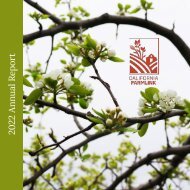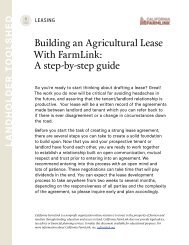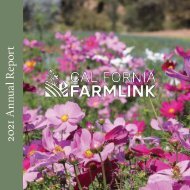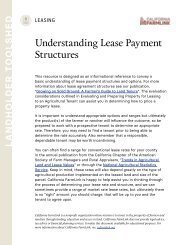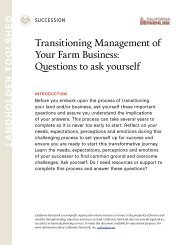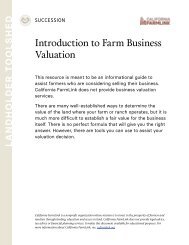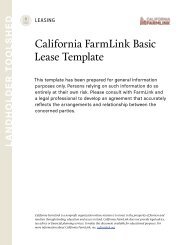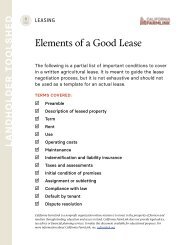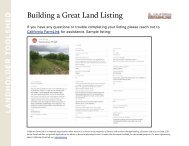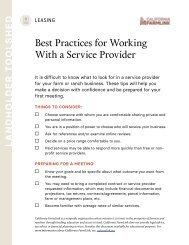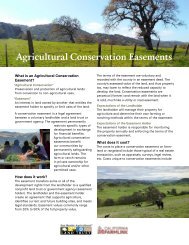Guide to Regenerative Grazing Leases: Opportunities for Resilience
California FarmLink and TomKat Ranch Educational Foundation teamed up to create this resource focused on land leases that support regenerative grazing practices. This guidebook aims to empower private, nonprofit, and public landholders, as well as easement-holders and grazing tenants.
California FarmLink and TomKat Ranch Educational Foundation teamed up to create this resource focused on land leases that support regenerative grazing practices. This guidebook aims to empower private, nonprofit, and public landholders, as well as easement-holders and grazing tenants.
Create successful ePaper yourself
Turn your PDF publications into a flip-book with our unique Google optimized e-Paper software.
FOREWORD (Continued)<br />
<strong>Regenerative</strong> graziers use lives<strong>to</strong>ck <strong>to</strong> mimic and enhance ecosystem processes<br />
<strong>to</strong> improve the resilience and productivity of rangelands. By blending conservation<br />
and agriculture, regenerative grazing can produce valuable products, services, and<br />
synergies that are mutually beneficial <strong>for</strong> graziers and their lives<strong>to</strong>ck, landholders and<br />
land trusts, conservation groups and surrounding communities of people and wildlife.<br />
Despite increasing interest and expertise in regenerative grazing, landholders<br />
and lessees often find themselves at a loss <strong>for</strong> lease language that promotes<br />
regenerative grazing and land management. This guidebook was designed <strong>to</strong> help<br />
landholders improve the productivity and resilience of their lands through strong and<br />
collaborative lease agreements, and <strong>to</strong> give innovative and skilled grazing managers<br />
guidance and support <strong>to</strong> build resilient, regenerative businesses.<br />
HOW TO USE THIS GUIDEBOOK<br />
This guidebook provides a framework <strong>for</strong> drafting rigorous grazing agreements<br />
that clearly articulate the shared agricultural, ecological, and social values of each<br />
party; foster effective communication <strong>to</strong> support adaptation and innovation; and<br />
align incentives so that the productivity and resilience of the lands are improved.<br />
In addition <strong>to</strong> the <strong>for</strong>mal lease, this guidebook also provides guidance on creating<br />
adaptive Agricultural Management<br />
Plans (AMPs)—<strong>to</strong> be used in<br />
conjunction with leases—that help<br />
landholders and lessees articulate<br />
the specific steps that will be taken<br />
<strong>to</strong> accomplish their shared goals. It<br />
concludes with a discussion of ranch<br />
succession, equity, and legacy.<br />
It is our hope that this guidebook<br />
will help readers design and<br />
maintain regenerative grazing leases<br />
on Cali<strong>for</strong>nia’s rangelands that<br />
reflect and support the resilience,<br />
adaptability, and outcomes they wish<br />
<strong>to</strong> see.<br />
It is our hope that this<br />
guidebook will help readers<br />
design and maintain<br />
regenerative grazing leases on<br />
Cali<strong>for</strong>nia’s rangelands –<br />
Cali<strong>for</strong>nia Farmlink and TomKat Ranch<br />
© Copyright 2022 Cali<strong>for</strong>nia FarmLink and TomKat Ranch Educational Foundation<br />
2



